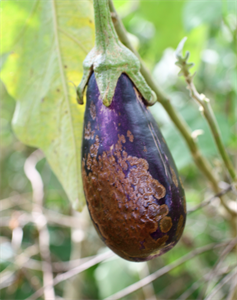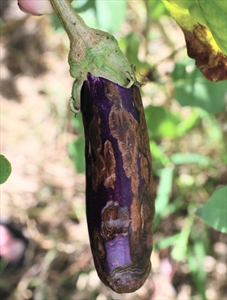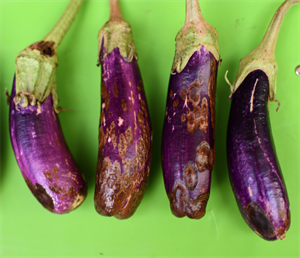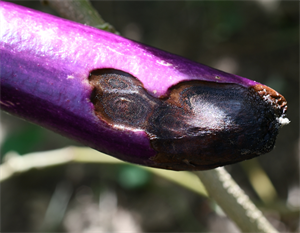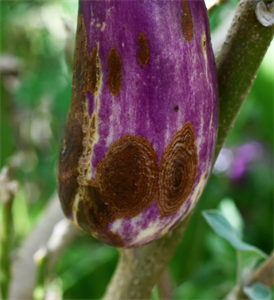- Worldwide distribution. Two species: Colletotrichum capsici from Cook Islands, Fiji, Niue, Papua New Guinea, Samoa. Solomon Islands, Tonga; Colletotrichum gloeosporioides most Pacific island countries. Cause fruit rots, leaf and flower spots and blights. Major problem on eggplant, chili and capsicum.
- Damage: multiple light-brown spots merging to form large, raised, warty, brown patches with concentric rings, especially at base of fruit, becoming sunken and developing masses of black fruiting bodies.
- Spread: spread in wind-driven rain, possibly by insects and tools. Long distance spread in or on seed and weeds.
- Cultural control: in nursery - disease-free seed (if unsure, treat 50°C for 30 mins); check each seedling; in field - 3-year rotation; weed; avoid overhead irrigation; collect crop debris and burn at harvest.
- Chemical control: use (i) protectants, e.g., mancozeb, copper products or chlorothalonil, or (ii) systemics, e.g., triazoles or strobilurins.
Pacific Pests, Pathogens and Weeds - Online edition
Pacific Pests, Pathogens, Weeds & Pesticides
Eggplant anthracnose (390)
Click/tap on images to enlarge
Summary
Common Name
Eggplant anthracnose, eggplant fruit rot
Scientific Name
Colletotrichum species, particularly, Colletotrichum capsici, and Colletotrichum gloeosporioides. The sexual state is Glomerella cingulata (see Fact Sheet no. 177).
AUTHOR Grahame Jackson & Unaisi Turaganivalu
Information from 1McKenzie E (2012) Pathogen Identification Manual 3: Export Commodities. Ministry of Primary Industries and Landcare Research New Zealand Limited.
Produced with support from the Australian Centre for International Agricultural Research under project HORT/2016/18: Responding to emerging pest and disease threats to horticulture in the Pacific islands, implemented by the University of Queensland and the Pacific Community.
